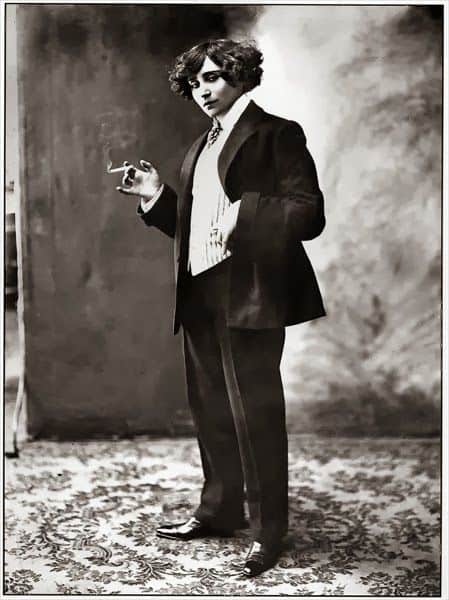Top 10 interesting facts about the French writer Colette
It seems that thee are no shortage of great French writers out there! Today I’m going to be telling you more about a woman who went by the name of Colette.
Colette was a celebrated French writer that lived and worked throughout the 20th century. She was nominated for the Nobel Prize in Literature in 1947, and although she didn’t win, she was respected by her peers and well-loved by her fans.
She lived a long and interesting life, and I’m so happy to be able to tell you about her. Colette is one of my personal favorites, and here are the top 10 interesting facts about this incredible French writer!
1. Colette was born in a small village in 1873
Colette was born as Sidonie-Gabrielle Colette in 1873 in a small village called Saint-Sauveur-en-Puisaye, which is in the Burgundy region of France.
Colette was very close with her mother, known as Sido, and she had a huge influence on Colette’s life, and later her writing. The family was originally fairly well-off, but ran into financial difficulties and had to give up their home. When she was 18 years old, Colette went to live with her older brother.
In 1893, Colette met and married a journalist named Henry Gauthier-Villars, who went by the pen name Willy. The pair moved to Paris, where Willy introduced Colette to the libertine society: filled with parties, excess and sexual liberty.
Willy was 14 years older than Colette, and happened to be one of the most famous libertines in Paris. One can assume that Colette began to experiment with swinging and began to have affairs with women. Willy encouraged all of this.
Willy also encouraged Colette to write. But, he would go on to essentially steal her work and publish her writing under his name.
2. Colette wrote over 80 works in her lifetime

This is the front cover art for the book Gigi written by Colette. The book cover art copyright is believed to belong to the publisher or the cover artist – WikiCommons
Colette lived a long and full life, and produced a massive amount of writing. Her most famous works include the Claudine series (more on that in the next section) and her novels Chéri, La Vagabonde (The Vagabond), Le Blé en Herbe (Green Wheat) and Gigi.
Gigi became so famous that it was recreated into a play, with a then-unknown Audrey Hepburn as the lead! Colette chose Hepburn herself, as she felt that she could best personify the main character of Gigi.
Colette did most of her writing during the 1920s and 1930s, after she was married for the second time to a man named Henry de Jouvenel, who was the editor at the Parisian newspaper Le Matin.
Most of her works are set in her home of Burgundy during the “Belle Époque,” a time period in European history from 1871-1914. Her stories usually concerned married women and brought up questions of married life and sexuality.
Her stories were also usually semi-autobiographical, and featured older married women who fell in love with much younger men. This will all make sense later when I explain what broke up her second marriage!
She also produced a lot of work during and after World War II. By this time Colette was praised for her talent and was considered one of the greatest female French writers of all time.
3. Colette’s first husband introduced her to the literary world
Colette often said that she would have never started writing if it wasn’t for her first husband Willy. Since he worked in the publishing business, he knew that the pair could make a substantial amount of money, once he saw what Colette could do.
Most of Colette’s works are auto-biographical, and her very first story was called Claudine à l’école (Claudine at School). Inside, she wrote about a teenage girls coming of age story, which included questioning her sexuality and getting into trouble.
The only problem was, Willy refused to let Colette publish her stories under her own name.
4. And then he took all of the credit for her genius

Front cover of 1st edition Claudine a l’école, 1900, published in Paris by Société d’Editions Littéraires & Artistiques. Notice that the author is listed as Willy – WikiCommons
As I mentioned above, Colette’s first batch of novels were the Claudine series. It included 4 titles: Claudine à l’école (Claudine at School), published in 1900, Claudine à Paris (Claudine in Paris), published in 1901, Claudine en ménage (Claudine Married), published in 1902, and Claudine s’en va (Claudine and Annie), published in1903.
These were all Colette’s works, but they were published under Willy’s name. Willy took all of the credit, and all of the money that they earned. Colette protested and, apparently, Willy responded by locking her away in a room so that she would continue to write.
By 1906, Colette had had enough and she separated from Willy. Since she was unable to receive any of the royalties from the Claudine series, she was forced to start working on her own. That’s how she ended up working as a music hall dancer!
5. Colette worked as a music hall dancer

Colette in the costume that she wore for her performance of the play Rêve d’Égypte at the Moulin Rouge in 1907 by
Léopold-Émile Reutlinger – WikiCommons
Colette and Willy were officially divorced in 1910. She suddenly found herself without any money or a job. So, she decided to become a music hall dancer. She would go on to perform across France, and she even played her character of Claudine on stage.
She once wrote in her novel The Vagabond (which tells the story of a recent divorcée trying to find her place in the world. Sound familiar?), “What else could I do? Needlework, typing, streetwalking? Music hall is a profession for those who have never learned one.”
While on tour she met and performed with a woman that was named Mathilde de Morny, and went by the nickname Missy. The pair shared a passionate kiss on stage at the Moulin Rouge in 1907 during one of the performances of the play Rêve d’Égypte (Egyptian Dream), which caused a scandal. Life would go on to imitate art for the two of them, but I’ll get more into their relationship coming up!
6. Colette had a line of beauty products
Colette was seriously strapped for cash after her divorce. Plus, the 1930s were a tough time for everyone. In addition to performing as music halls, she also created a line of beauty products and cosmetics!
She worked alongside a chemist to create a line of products. She went on to travel around France to sell her goods! She visited 30 different places and set up a showroom in Saint Tropez.
In addition to her line of beauty products, Colette also tried her hand at copywriting, advertising, and she also did some modelling. She even appeared in some ads herself, allowing brands to photograph her while she was holding their products.
In the end Colette decided to stick with writing, but I love that she set out on her own in order to make her own living.
7. Colette had several affairs with women
As I’ve already mentioned, Colette shared an onstage kiss with a woman named Missy. After the couple was booed off stage for sharing a kiss, they continued their relationship in secret. They were together for more than 5 years.
The identities of Colette’s other lovers are unknown, but it’s certain that thanks to her relationship with Missy allowed her to enter into the lesbian scene in Paris at the time. I also love this side to Colette: it is clear that she bounced back from her tumultuous relationship with Willy and came back better (and more herself) than ever.
8. Colette had one daughter

Henri de Jouvenel, Colette’s second husband and the father of her child, Colette de Jouvenel – WikiCommons
Colette had only one daughter, with her second husband. Her name was Colette de Jouvenel, and was lovingly called Bel-Gazou, which means “warbling bird” in Provincial French.
Colette was 40 years old when she had her daughter, and it became well-known that she was a neglectful mother. Colette blamed this on her age and her lifestyle. Apparently, weeks and months would go by without any communication between the mother and daughter.
I find this strange, seeing as though Colette was so close with her own mother Sido. I guess I’ll never know the motivation behind Colette’s estranged relationship with her daughter!
9. Colette seduced her stepson
This is another move by Colette that I don’t really understand but, hey, to each their own!
Colette’s second husband had a son that lived with the family. His name was Bertrand de Jouvenel and he was just 16 years old at the time. Now do you understand why her stories that featured older women that fell in love with younger men were semi-autobiographical?
May believe that the novel Chéri was inspired by this real life event, but Colette actually touches on it in Green Wheat.
Not surprisingly, the affair led to the demise of Colette’s relationship with Henry de Jouvenel. The couple divorced in 1924.
10. Colette’s third husband was arrested by the Nazis for his Jewish faith
It seems that Colette finally found true love in her third husband, a man named Maurice Goudeket. She met him in 1925, just one year after her second divorce. The couple would remain together until her death in 1954. He was 16 years younger than her.
Goudeket was Jewish, and was arrested by the Gestapo in Paris in 1941. He remained in custody for just a few months, thanks to some of Colette’s high standing connections. She was friends with the French wife of the German ambassador in Paris at the time, and Goueket was allowed to come home.
Although her husband was back home safely, Colette lived in fear for the rest of the war. She remained in Paris throughout the German occupation in her apartment in the Palais Royal.
Ironically, during this time Colette wrote articles for several pro-Nazi publications, and she wrote. a novel, Julie de Carneilhan, which contains anti-semitic slurs. Maybe she was trying to ensure the Gestapo that they needn’t worry about her and her husband, and that they were on the Nazi’s side? This is another question I think will remained unanswered!
Conclusion
I hope you’ve enjoyed learning more about the French writer, Colette! I would have loved to have been able to meet her in Paris in the 20th century. I have so many unanswered questions! I guess I’ll have to be satisfied with reading her novels, one of which I just purchased today.
If you’d like to visit Colette’s grave, you can find it in the Père Lachaise cemetery in Paris.
If you want to learn more about famous French authors, painters and other personalities, why not join one of our walking tours in Paris? Click here to discover more, and to make your booking!
Planning a trip to Paris ? Get ready !
These are Amazon’s best-selling travel products that you may need for coming to Paris.
Bookstore
- The best travel book : Rick Steves – Paris 2023 – Learn more here
- Fodor’s Paris 2024 – Learn more here
Travel Gear
- Venture Pal Lightweight Backpack – Learn more here
- Samsonite Winfield 2 28″ Luggage – Learn more here
- Swig Savvy’s Stainless Steel Insulated Water Bottle – Learn more here
Check Amazon’s best-seller list for the most popular travel accessories. We sometimes read this list just to find out what new travel products people are buying.
















